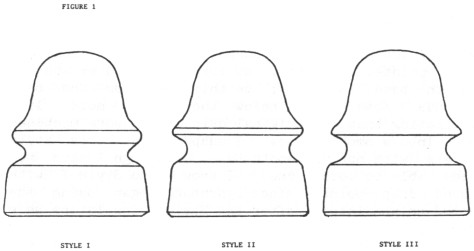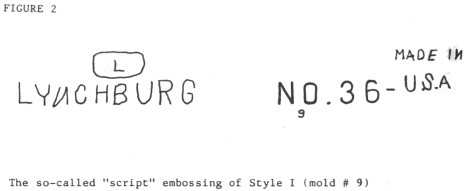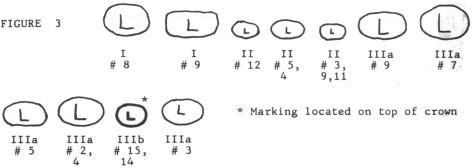Varieties of Lynchburg Glass, Part I
by Dennis Bratcher
Reprinted from "Crown Jewels of the Wire", April 1986, page 11
The story of the Lynchburg Glass Works reads like a Shakespearean tragedy: a
promising enterprise with the right product in the right place at the right
time, with good motivation and management, an aggressive sales program and the
right "contacts," but doomed to failure by forces beyond the control
of the participants. The well preserved record of Lynchburg allows us a rare
look into the history of an insulator company, an opportunity denied us for most
other small insulator manufacturers. Thanks to Mr. Woodward's research, we know
about the strange twist of fate (or was it?) that left a gas line valve
partially closed and condemned the company to failure before it melted its first
batch of glass. Such quirks of fate are the stuff of good tragedy. Good fuel,
too, for the fires of imagination and speculation. Was the closed valve really
an accident or was it sabotage? Could it be that someone purposely closed the
valve knowing that it would bankrupt the company? Was it a disgruntled employee?
Or was it someone who disliked Mr. Gayner? A competitor who realized the
potential of the company? Someone angry because of Mr. Gayner's reuse of other
companies’ equipment? The questions and speculation could go on with, perhaps,
no final answer.
But the fact is that the partially closed valve caused continued financial
problems for Lynchburg throughout its short life. Even though the equipment was
top quality for its day and sales were good, the company operated on a
"shoestring" and fought constantly to show any kind of profit. This
"shoestring" operation is evidenced to the collector by the fact that
most insulators made at Lynchburg were produced in second-hand molds from other
companies, molds that were reworked in the Lynchburg shops and retooled in
various ways to meet particular needs. While Lynchburg Glass had the capability
to tool their own molds, all but two of the fourteen known styles produced by
Lynchburg were produced in reworked molds; and even these two were first
produced in second-hand molds. I would not attempt to speculate whether these
molds were legally obtained or were “pirated” from other companies. From the
case of McLaughlin Glass Works we know that the unauthorized use of equipment
was a problem. There are also reports of molds and equipment being sent to
unscrupulous scrap dealers for demolition but then being
"black-marketed" back into the trade. But it is just as possible that
the molds used at Lynchburg were obtained quite legally from defunct companies.
In any case, the reuse of old molds makes for some interesting variations of
Lynchburg insulators. It is my goal to put together a series of articles on the
varieties of Lynchburg glass to highlight some of these variations. Whether that
goal becomes a reality or not remains to be seen. I will begin with one of the
most common Lynchburgs, the CD 162. I should insert a disclaimer here: this is
not meant to be an exhaustive survey of these varieties since there are some I
know or suspect exist but which I have been unable to track down. I would
welcome any additional information in any area of Lynchburg production.
There are three basic variations or styles of the Lynchburg CD 162 No. 36
(figure 1). Style I was made from the old Gayner molds brought to Lynchburg by
Mr. Gayner when he joined the company. These insulators are characterized by a
very narrow wire groove (12.5 mm/approx. 1/2") with rounded edges and a
thick upper ridge. On most of these insulators there are six clearly
distinguishable circular blot-outs on the front over which is embossed
LYNCHBURG; on some, various parts of the letters GAYNER can be seen in the
circles. There is normally the trademark "L" in an oval above
LYNCHBURG. On the reverse the original Gayner lettering No. 36, along with the
mold number under "NO.", are left intact while the "190"
portion of the Gayner lettering is replaced by three circular blot-outs over
which is embossed MADE IN/U.S.A. in two lines. There was at least one mold used
for a time (unfortunately, I have not been able to track down the mold number)
in which the reverse lettering of the Gayner mold was not changed from the NO.
36-190; on this same mold, the "L" trademark was also omitted from the
front.

It is on some Style I Lynchburgs that the so-called "script” lettering
occurs. The "script" is simply very crude lettering in which
LYNCHBURG, the "L" trademark and MADE IN/U.S.A. are roughly scratched
into the mold over the Gayner blot-outs (figure 2). I have seen this in two
variations on two different molds: mold #9 with the "N" in LYNCHBURG
backwards and the lettering of uneven height; and mold #8 with correct even
lettering only crudely done. It is interesting to note that mold #9 was later
retooled (to a Style III, see below) and the lettering redone. On the retooled
version, the backward "N" can still be seen faintly beneath the re-
engraved "N." There are reports of at least one other mold of the
"script" with the "G" upside down, but I have been unable to
confirm it.

Most of the Style I Lynchburgs have 35 sharp (conical) drip points. However,
at least one mold exists in smooth base (mold #8); on this insulator the base
extends some 3 mm below the bottom mold line indicating that the original drip
points were machined out into a smooth base. I suspect that this style exists
with normal smooth base, although I have not been able to locate one. I know of
no Style I with round drip points since Lynchburg began using the round points
later, after the Style I insulators were reworked into Style III's. I have seen
Style I only in the medium shades of Aqua, blue-aqua and a sagey-green aqua.
Style II was made from reworked Brookfield molds. These insulators are
characterized by a medium-sized wire groove (16mm/approx. 5/8") with
rounded edges, but with a much thinner upper ridge than Style I. Another feature
of most Style II Brookfield molds is a line, resembling a mold line although
actually simply a feature of the tooling process, which encircles the upper dome
of the insulator approximately l/2" from the top center (in profile). On
some insulators this line is easily seen and felt while on others it is barely
distinguishable or invisible. The lettering on most of this style is uniform and
sharp (literally!) coming to a pronounced edge at the upper surface of the
letters. The "L" trademark on the front is usually quite small (10mm)
(figure 3) and the letters generally do not exceed 7mm in height, often smaller.
The reverse lettering is arranged differently than Style I: NO. 36 is centered
in one line while below it in a second line are MADE IN followed by a mold
number in a wide space and then U.S.A. On many of this style the lettering
BROOKFIELD and NEW YORK can be seen beneath the Lynchburg embossing (e.g. molds
#5, 9, 11). All of this style that I have seen had 35 sharp drip points. I
suspect that a smooth base Style II exists; I doubt that it was produced with
round drip points. Likewise, although I am sure other color varieties exist, I
have seen this style only in the lighter shades of aqua and blue aqua, as well
as a milky translucent (jade) blue-aqua.
Style III could be called the "distinctive" Lynchburg CD 162 since
its profile is unique and easily distinguishable (even from the ground on a
25-foot pole!). This distinctive shape comes from a wider and deeper wire
groove. While the overall width of the wire groove is about the same as the
Style II (between 16mm (5/8") and 17.5mm (11/16") the effective width
of the groove is greatly increased because both upper and lower edges of the
groove turn sharply into the groove rather than being rounded. This style is the
result of a retooling of both the Gayner (Style I) and Brookfield (Style II)
molds to produce a more serviceable wire groove. It can be speculated (and only
a guess) that Lynchburg received complaints because of the rather tiny wire
groove on the Gayner style and subsequently retooled most of the No. 36 molds to
new specifications.
Since both Style I and Style II were retooled, there are two minor varieties
of Style III. Style IIIa is the retooled Gayner Style I. The variety is the most
distinctive in shape since the wide upper ridge and thick body of the Gayner
molds allowed more modification. The upper wire ridge was retooled just below
the mold line (which occurs almost centered in the upper wire ridge) leaving a
smooth, rounded top half while the bottom half breaks sharply into the wire
groove. The entire groove was cut deeper (the mold filled) leaving a pronounced
edge between the lower portion of the wire groove and the bottom skirt. The
Style IIIa, then, can be distinguished by the wide wire groove (17.5 mm/approx.
11/16"), the arrangement of the reverse lettering (No. 36 - followed by
MADE IN/U.S.A. in two lines), and the absence of the line encircling the crown
distinctive of the Brookfield molds.
On most Style IIIa the "L" and oval trademark on the front is quite
large (15-17mm; figure 3) as is the lettering (7-10mm) suggesting that perhaps
the lettering was re-engraved in the retooling process. On some specimens the
circle blot-outs over GAYNER can faintly be seen beneath LYNCHBURG (molds #1, 7)
although this is unusual since the molds would undoubtedly be worn by the time
the retooling was done. The lettering on this style (and IIIb as well) is
usually rounded on the upper surface rather than coming to a sharp edge. This
could result from worn molds, although it appears that a different instrument
was used to engrave the letters.

Examples of Lynchburg's trademark on CD 162s. The Roman numeral
designates the style number and the Arabic number (with #) designates
the mold number.
On at least one mold of Style IIIa (mold #3) the lettering on the reverse
appears to have been done entirely at Lynchburg (as opposed to retaining
"NO. 36" from the Gayner embossing) since the "NO. 36" is a
little "rougher" than normal Gayner lettering. The arrangement of
lettering on the reverse of this mold is also different, in fact unique: NO. 36
U.S.A. in one line. This lettering is off center to the right, "made
in" is omitted, and the mold number is placed between and below the
"6" and "U." A second interesting mold of Style IIIa is mold
#9 which is easily recognized as the retooled mold #9 of Style I. Not only has
the mold been retooled into the wider grooved Style IIIa, but the
"script" lettering was also re-engraved and errors corrected.
Style IIIb is similar to the IIIa except it was retooled from the Brookfield
molds. The wire groove is slightly narrower than IIIa (16mm/approx. 5/8")
and the lower skirt below the wire groove is often the difference in the width
of the wire groove taller (about l.5 mm). The dome also usually has the
characteristic line around it approximately l/2" from the top. The
lettering arrangement is the same as Style II. I am not sure whether it is a
characteristic only of Style IIIb or not, but all CD 162 Lynchburgs that I have
seen with the "L" trademark placed on top of the crown have been Style
IIIb in the higher mold numbers, specifically molds #14 and 15.
Since Style III is by far the most common Lynchburg CD 162, it occurs in
almost all the colors that Lynchburg glass occurs in: from very light ice blue
to dark aqua and blue-aqua; from very light sage green to deep yellow-green and
olive. At present, I know of only one of the three "shades" of clear
common to other types of Lynchburg insulators: a smokey-clear with a light
greenish tint. Too, the style occurs with drip points, usually numbering 35, and
with smooth base. There are three types of drip points: the "normal"
sharp points which are actually cone- shaped; more rounded points which are not
really round but more nipple-shaped; and truly round points that are generally
large and hemispherical. Since all three types of drip points, as well as smooth
base, occur on the same mold number (IIIb, #15, e.g.), I suspect Lynchburg used
a separate "collar" on some (later) molds to produce the points, while
on other molds (IIIa, #5; I, #8) the drip points were part of the mold and were
simply machined out to produce a smooth base.
A final anomaly should be noted. One mold number (310) appears to be a Style
IIIb, since it has the 16mm wire groove and the circle around the dome. However,
it also has the shorter skirt as well as the size and arrangement of lettering
characteristic of IIIa. I suspect that this insulator is a hybrid produced with
a Brookfield top mold and retooled Gayner bottom halves. This simply represents
an efficient re-use of spare parts which would typify a company operating on a
"shoestring" and struggling to survive.
| 